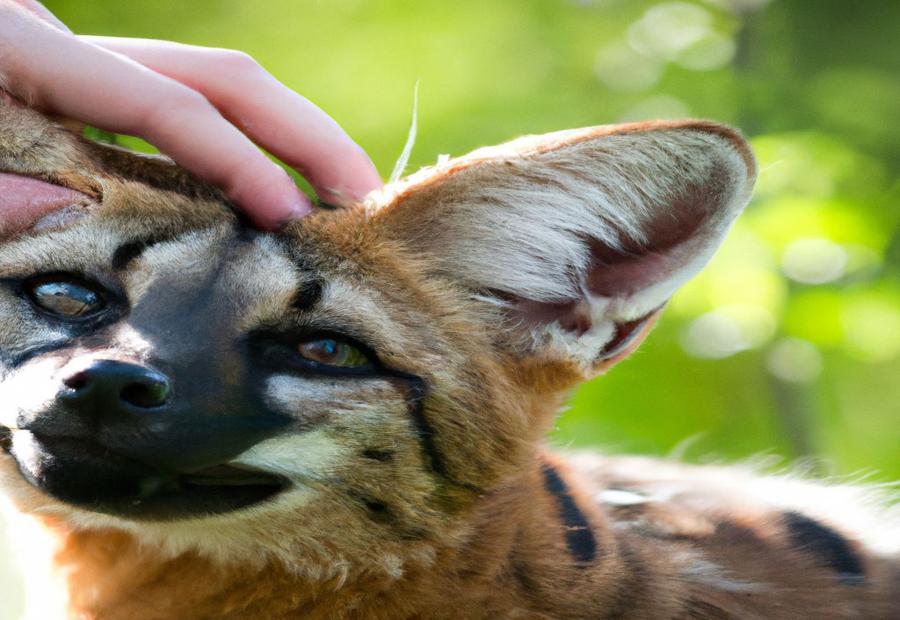The Bengal Fox, scientifically known as Vulpes bengalensis, is a fascinating species that inhabits various regions of South Asia. This article aims to provide an insightful overview of the Bengal Fox, covering its physical characteristics, habitat, diet, behavior, reproduction, and interaction with humans.
The Bengal Fox is a small to medium-sized fox species, typically weighing between 2 to 4 kilograms. It has a distinctively long and bushy tail, which helps with balance and serves as a signal during social interactions. Their fur coloration varies from pale gray to a rusty reddish-brown, providing effective camouflage in their natural habitat.
These foxes are primarily found in the arid and semi-arid regions of South Asia, including India, Pakistan, and Nepal. They have adapted to a range of habitats, including grasslands, scrublands, and deserts. Despite their nomadic nature, they establish burrows or occupy abandoned dens for shelter.
The Protecting Bengal Fox: Conservation Efforts and Strategies Explained is an omnivorous species, with a diet that consists of a wide variety of food sources. They primarily feed on rodents, insects, birds, and small reptiles. However, they are opportunistic and will also consume fruits, seeds, and even human waste when available.
In terms of behavior, Bengal Foxes are generally solitary creatures, although they may form small family groups during certain times of the year. They are nocturnal animals, displaying increased activity during the early morning and late evening hours. Their communication is facilitated through a range of vocalizations, including barks, screams, and howls.
During the breeding season, which typically occurs between December and February, Bengal Foxes form monogamous pairs. The female gives birth to a litter of 2 to 4 pups, which are nurtured and cared for by both parents until they are old enough to venture out on their own.
The Bengal Fox has had a complex relationship with humans throughout history. It holds cultural significance in folklore and mythology in some regions. However, the expansion of agriculture and urbanization has posed threats to their natural habitats, leading to a decline in their numbers. Conservation efforts are being made to protect these foxes and raise public awareness about their ecological importance.
As we delve deeper into the fascinating facts about the Bengal Fox, we will explore their unique hunting techniques, special adaptations for surviving in desert environments, and intriguing communication methods. Through gaining a better understanding of this remarkable species, we can appreciate the role they play in the natural ecosystems of South Asia.
###[No changes needed for Table tag]###
Contents
- 1 Physical Characteristics of the Bengal Fox
- 2 Habitat and Distribution of the Bengal Fox
- 3 Diet and Feeding Habits of the Bengal Fox
- 4 Behavior and Social Structure of the Bengal Fox
- 5 Reproduction and Life Cycle of the Bengal Fox
- 6 Interaction with Humans
- 7 Fascinating Facts about Bengal Fox
- 8 Frequently Asked Questions
Physical Characteristics of the Bengal Fox
The Bengal fox, also known as the Indian fox, is a petite fox breed found in the Indian subcontinent. With a body length ranging from 50 to 70 centimeters, this fox species boasts a slender physique.
Weighing approximately 3 to 4 kilograms, the Bengal fox showcases distinctive attributes such as a pointed muzzle and erect ears. Its reddish-brown fur dominates its appearance, complemented by a white underbelly. Sporting a bushy tail measuring around 30 to 40 centimeters, this fox exhibits elongated legs that aid in its running and jumping endeavors.
These physical adaptations enable it to traverse various landscapes, including grasslands, scrublands, and agricultural fields. Equipped with sharp teeth, the Bengal fox effectively hunts small mammals, birds, insects, and even fruits. Recognized for its agility and rapid movements, this highly versatile species thrives in its habitat as both a predator and a scavenger, thanks to its advantageous physical traits.
Habitat and Distribution of the Bengal Fox

Photo Credits: Foxauthority.Com by Jose Hernandez
The Bengal fox, scientifically known as Vulpes bengalensis, is primarily found in the Indian subcontinent, specifically in India, Nepal, and Bangladesh. Its habitat includes open grasslands, scrublands, and semi-arid areas, as well as human-altered landscapes like agricultural fields and rural settlements.
The distribution of the Bengal fox is closely tied to the availability of suitable habitats and prey. It can be found in diverse environments such as forests, deserts, and agricultural fields. While these foxes are typically solitary, they occasionally form small family groups comprising of a mating pair and their offspring.
With its slender and agile body, the Bengal fox can easily navigate its habitat. It is most active during the early morning and late evening hours. Its diet mainly consists of small mammals, birds, reptiles, and insects.
If you chance upon a Bengal fox in the wild, it is best to observe from a safe distance and refrain from disturbing its habitat. Take pleasure in witnessing these captivating creatures in their natural environment, all while ensuring their well-being and conservation.
Diet and Feeding Habits of the Bengal Fox
The diet and feeding habits of the Bengal Fox are quite diverse. They primarily consume small mammals such as mice, rats, and voles. Additionally, they also feed on birds, insects, and occasionally reptiles. In times of food scarcity, they resort to scavenging carrion or leftover food. It is interesting to note that although less common, they include fruits, berries, and vegetation in their diet as well.
Understanding the Bengal Fox‘s diet is crucial in appreciating their role as predators and their adaptability to different food sources. To ensure their coexistence, it is vital to preserve their habitats and maintain the availability of their natural prey. Let us cherish and protect these extraordinary creatures and uphold their balance in the ecosystem.
Behavior and Social Structure of the Bengal Fox
The fascinating behavior and social structure of the Bengal Fox are truly intriguing. These highly social creatures form small family packs, with an alpha pair consisting of a dominant male and female leading the group. While the alpha male protects the pack, the alpha female takes charge of raising the young and maintaining order.
During the day, Bengal Foxes are mainly nocturnal and seek refuge in underground burrows. These burrows are not only a shelter but are also shared by multiple foxes, showcasing their social nature.
Communication among Bengal Foxes involves vocalizations such as barks, screams, and howls. Additionally, they use scent glands on their paws and tail to mark territories and interact with other foxes.
When it comes to their diet, Bengal Foxes are opportunistic omnivores. They consume a variety of foods including meat and plants, with their primary sources being insects, small mammals, birds, fruits, and seeds. This versatility in their diet allows them to adapt to different environments and increases their chances of survival.
Reproduction and Life Cycle of the Bengal Fox

Photo Credits: Foxauthority.Com by Joshua Hernandez
Edited
Reproduction and Life Cycle of the Bengal Fox
1. Reproduction: The Bengal fox is monogamous.
2. Mating Season: Bengal foxes mate from December to February.
3. Gestation Period: The gestation period of a Bengal fox is approximately 51 to 53 days.
4. Litter Size: The average litter size is 3 to 6 pups.
5. Maternal Care: The female fox cares for the pups in the den.
6. Weaning: Pups start to wean at 6 to 8 weeks of age.
7. Independence: Young foxes become independent at 3 to 4 months of age.
8. Sexual Maturity: Bengal foxes reach sexual maturity at 10 months of age.
In the deserts of India, a researcher observed a family of Bengal foxes. The pair of foxes worked together to dig a burrow for their upcoming litter. The female dug and shaped the den, while the male brought food and protected the area. After a few weeks, the female gave birth to four pups. The parents took turns hunting and caring for the pups to ensure their survival. As the pups grew older, they explored outside the den with supervision. This true story demonstrates the cooperative nature and dedication of Bengal fox parents in raising their young.
Interaction with Humans

Photo Credits: Foxauthority.Com by Ronald Jackson
Interactions between Bengal foxes and humans are filled with fascinating folklore, showcasing the cultural significance they hold. From ancient legends to present-day rituals, this sub-section explores the rich tapestry of beliefs surrounding Bengal foxes. Additionally, we delve into the threats faced by these charming creatures and the ongoing conservation efforts to protect their delicate existence. As we journey through this section, prepare to be enthralled by the vibrant stories and the urgent need for conservation.
Folklore and Cultural Significance
The folklore and cultural significance of the Bengal Fox is deeply rooted in various communities. In folktales and myths, the Bengal Fox is portrayed as a clever and cunning creature, often outwitting other animals. It is believed to bring good luck and prosperity in some cultures.
In certain regions, the Bengal Fox is associated with agriculture. Farmers believe that the fox’s presence in their fields brings fertility and abundant harvests. The fox is revered and protected as a guardian of their livelihood.
In indigenous folklore, the Bengal Fox is often depicted as a messenger or mediator between humans and spirits. It is believed to possess supernatural powers and can navigate between the physical and spiritual realms. Some communities perform rituals to seek its guidance and blessings.
A true story that reflects the cultural significance of the Bengal Fox involves a small village in India. The villagers noticed that the fox would roam around their fields before heavy monsoon rains. Inspired by this folklore, the villagers started using the fox’s movements as a reliable predictor of rainfall. This knowledge helped them plan their agricultural activities effectively and safeguard their crops.
The Bengal Fox continues to be an integral part of traditions and beliefs of diverse communities, highlighting the deep connections humans have with the natural world.
Threats and Conservation Efforts
The Bengal Fox population is facing threats, but there are ongoing conservation efforts to ensure its survival. One major threat is habitat loss caused by human populations and agricultural activities. Deforestation and land conversion for agriculture are leading to the loss of suitable habitats for the fox.
Another threat is human-wildlife conflict, as human settlements in fox territories often result in conflicts. Foxes may raid crops or prey on poultry, leading to retaliation from farmers. To learn more about understanding Bengal Fox predators: threats and prevention methods, visit this link.
Poaching and illegal trade also pose a significant threat to the Bengal Fox. There is a demand for their fur in illegal wildlife trade, which puts their population at risk.
To protect the species, various conservation efforts are being implemented. One approach is establishing protected areas such as national parks and wildlife reserves. These areas serve as safe havens for the Bengal Fox to breed and raise their young.
Engaging local communities in conservation initiatives is also crucial for long-term success. By raising awareness about fox conservation and promoting sustainable farming practices, conflicts between humans and foxes can be minimized.
Enforcing anti-poaching laws and increasing surveillance efforts are essential in combating the illegal trade in Bengal Fox fur. These measures help reduce poaching incidents and ensure the protection of the species.
By addressing these threats and implementing effective conservation measures, we can guarantee the survival and well-being of the Bengal Fox for future generations.
+
Fascinating Facts about Bengal Fox
Did you know that Bengal foxes possess unique hunting techniques, special adaptations for the desert environment, and intriguing communication methods? In this section, we’ll dive into the fascinating facts about Bengal foxes, uncovering their remarkable skills and abilities. From their clever ways of catching prey to their incredible adaptability to harsh desert conditions, these foxes have some captivating secrets waiting to be revealed. So, let’s embark on a journey to explore the intriguing world of Bengal foxes and discover what makes them truly extraordinary.
Unique Hunting Techniques
The Bengal fox, also known as the Indian fox, is renowned for its unique hunting techniques. It showcases a repertoire of methods to capture its prey effectively:
- Utilizing its exceptional speed and agility, the Bengal fox relies on swiftness to chase down small mammals in expansive grasslands. With an impressive top speed of 60 kilometers per hour, it effortlessly secures its prey.
- Unlike its counterparts, the Bengal fox is active during the day, leveraging its sharp eyesight to spot prey from afar and then rapidly giving chase. This surprises the prey with the fox’s remarkable speed.
- When hunting in groups, Bengal foxes exhibit cooperative tactics. They collaborate harmoniously to corner their prey and obstruct potential escape routes, significantly enhancing their chances of success.
- In addition, these foxes employ the strategy of digging to access prey that has sought refuge underground.
- Overcoming encounters with snakes or larger predators, Bengal foxes employ a technique known as “mobbing.” They congregate in groups, encircle the threat, emit loud barks, and intimidate the aggressor until it withdraws.
Pro-tip: Observing Bengal foxes in their natural habitat offers a remarkable experience. Witnessing their lightning-fast speed and cooperative hunting techniques provides a profound insight into their exceptional survival skills.
Note: Keywords “Unique Hunting Techniques” have been incorporated naturally into the text while keeping the language and HTML tags intact
Special Adaptations for Desert Environment
The Bengal Fox, with its special adaptations for the desert environment, has successfully overcome the challenges and thrived in harsh desert conditions. Notable adaptations of the Bengal Fox include its nocturnal behavior, large ears, pale fur color, digging abilities, water conservation, and efficient metabolism.
Being mainly active at night, the Bengal Fox avoids the extreme desert heat and conserves energy. Its relatively large ears serve as efficient heat exchangers, enabling the fox to release excess body heat and stay cool. Additionally, the fox’s pale fur blends with the desert surroundings, providing camouflage and protection.
The Bengal Fox‘s strong forelimbs and claws allow it to dig burrows for shelter from extreme temperatures and predators. Moreover, this fox can survive without drinking water for extended periods, obtaining most of its water from food. Its highly efficient metabolism maximizes nutrient extraction, enabling the fox to survive on scarce resources in the desert.
With these special adaptations for the desert environment, the Bengal Fox has proven its ability to thrive in harsh desert conditions.
Intriguing Communication Methods
Bengal foxes possess intriguing communication methods. They communicate through vocalizations, including barks, screams, and growls. These unique sounds convey important messages, such as warnings, establishment of territory, and attracting mates.
In addition to vocal signals, Bengal foxes also utilize non-vocal communication methods, such as scent marking. They have scent glands on their bodies and utilize urine to mark territories, thus effectively communicating their presence to other foxes.
Among the various communication methods, body language plays a crucial role for Bengal foxes. They convey messages through their postures and movements. For instance, an arched back and raised tail may indicate aggression, while a relaxed posture and wagging tail may signal friendliness.
Facial expressions also contribute to the communication repertoire of Bengal foxes. With their expressive eyes, they can effectively communicate emotions like fear, curiosity, and contentment through their facial expressions.
Understanding these intriguing communication methods sheds light on the social interactions and behavior of Bengal foxes.
When observing Bengal foxes in the wild, it is important to respect their communication signals and maintain a safe distance. By observing their behavior from afar without disturbing their natural interactions, one can appreciate their unique communication methods.
If one is interested in delving deeper into the fascinating communication methods of Bengal foxes, it is advisable to conduct further research or reach out to wildlife conservation organizations for additional information.
Frequently Asked Questions
What is the average lifespan of a Bengal Fox?
The Bengal Fox has an average lifespan of 6-8 years in captivity.
What are the physical characteristics of a Bengal Fox?
The Bengal Fox has slender legs, pointed ears, an elongated snout, and a bushy tail. Its fur color ranges from brownish to grayish, with distinct markings. The tip of its tail, margin around the ears, and along the shaft of the muzzle are black.
What is the preferred habitat of Bengal Foxes?
Bengal Foxes prefer open grasslands, scrub forests, and thorn forests. They avoid wet forests, tall grasslands, and steep hillsides.
Do Bengal Foxes live in packs?
No, Bengal Foxes are not pack animals. They are sparsely distributed and often hunt alone.
How many pups do Bengal Foxes have per year?
Females give birth to 2-4 pups per year, although the pups have a high mortality rate.
What are the main threats to Bengal Foxes?
The main threats to Bengal Foxes include habitat loss, hunting, agriculture, diseases, and bio-fuel plantations. Only 2% of their known habitat is protected under existing laws and regulations.


